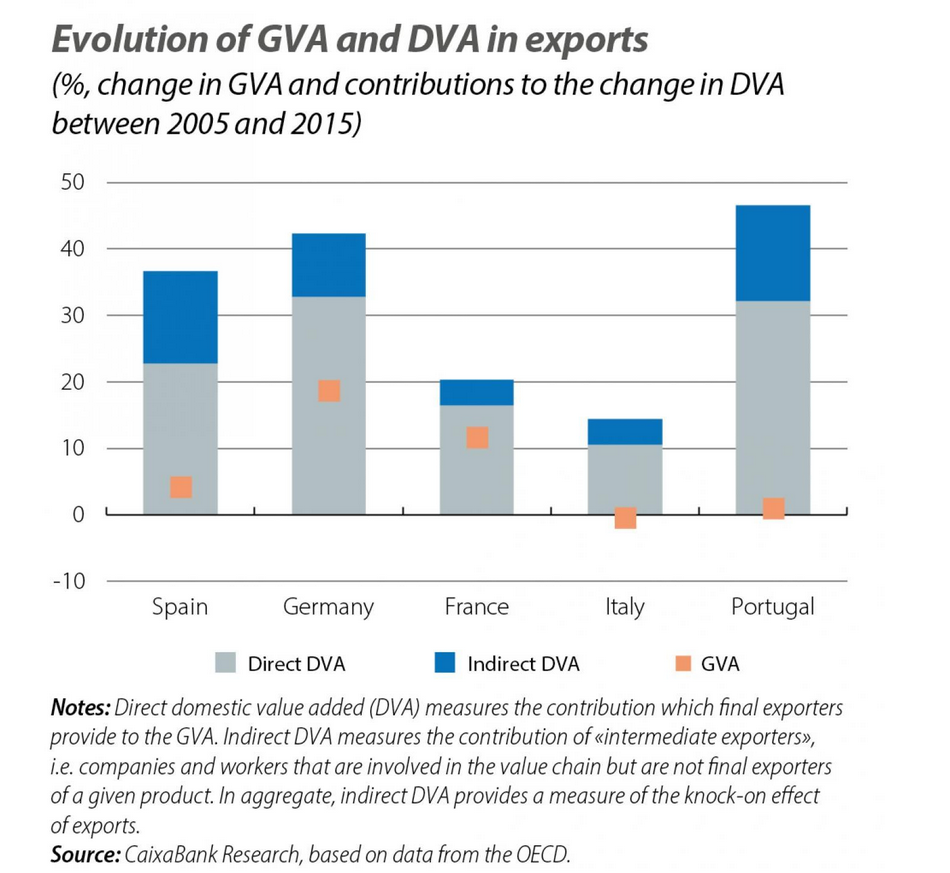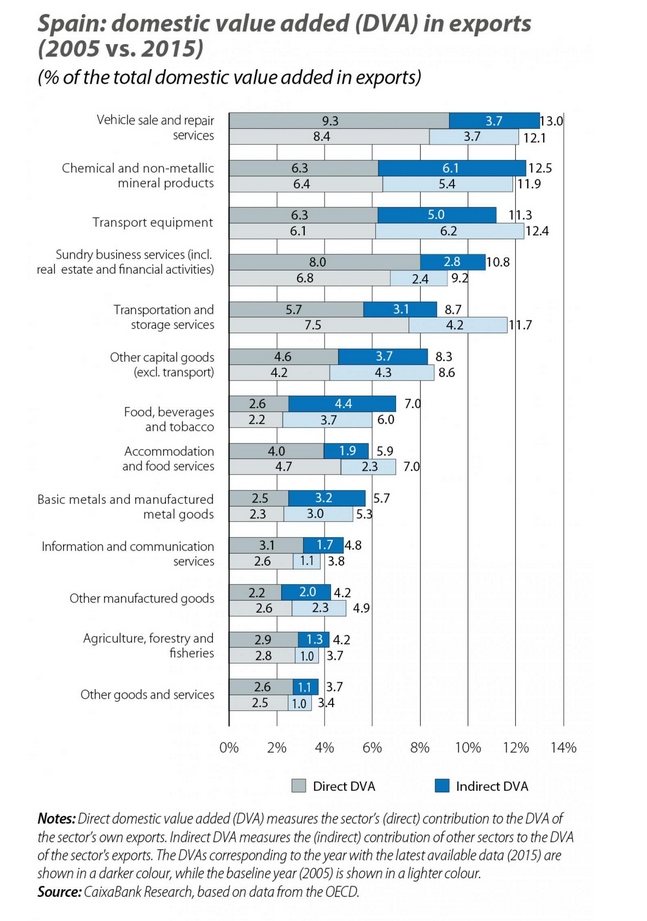Luís Pinheiro de Matos (Caixabank Research)| In an environment marked by fragmented production chains, increasing «servification» and the digitalisation of the economy and international trade – where final goods increasingly include more services in their value chains, services themselves become more marketable and companies incorporate information and communication technologies more intensively into their production processes – it is important to understand the evolution of Spanish exports from a value added perspective. Domestic value added (DVA) in exports offers us a measure of the value that is added by Spanish workers and firms to the products and services which they export. Between 2005 and 2015, Spain’s DVA amassed a growth of 38%, a particularly noteworthy figure in the context of a double-dip recession in which the gross value added (GVA) of the economy as a whole rose by just 4% (see first chart).

In addition, we can split the DVA in exports between direct DVA, which is the value added generated in the final export sectors of each country, and indirect DVA, generated in other sectors that are considered intermediate in each value chain but which nevertheless add value to exports of «final» goods and services. With this distinction, we see that the growth in DVA in Spanish exports has an unusually high contribution from indirect DVA, which is responsible for 16 pps of the total growth of the DVA in exports, well above that observed in other European countries (5.5 pps in France and 9 pps in Germany). Internationalisation and value added: knock-on capacity and services
But how did these exports grow? By sector, the main exporters in terms of DVA are vehicle sale and repair services, chemical and non-metallic mineral products, transport equipment and sundry business services. If we distinguish between direct DVA (originating directly in the sector) and indirect DVA (originating in other sectors, but incorporated into the exports of the final export sector), we see that exports of the manufacturing sector stand out for their knock-on effect. In particular, in the agrifood and metallurgical industries, indirect DVA accounts for around 60% of the total export DVA, and in the petrochemical and transport goods sectors it exceeds 50%. In addition, between 2005 and 2015, the agrifood sector and information and communication services are among those that have seen their indirect effect increase the most, making a significant contribution to the growth of the relative importance of these exports to the Spanish economy. Also of note is the increase in direct DVA in information and communication services, as well as in commercial and other business services, reinforcing the importance of these sectors to Spain’s exports (see second chart).

An analysis of the trade balance from a value-added perspective gives us a more accurate picture of how the foreign sector’s performance has evolved over time. In particular, it enables us to unravel how each sector, whether directly or indirectly, provides value added and to what extent its foreign dimension is significant for the national economy. First of all, it is noteworthy that all of the sectors analysed provided a positive contribution to the dramatic improvement in the trade balance between 2005 and 2015, with the exception of the «other manufactured goods» category (explained entirely by the deterioration in the external deficit of the textile sector). Secondly, the significant improvement in commercial services and other business services is worth highlighting, marking the key role played by services throughout the value chain of the Spanish economy, with an aggregate contribution of 4 pps to the improvement in the trade balance over the period in question (see third chart). Among goods, the performance of certain heavy manufacturing sectors with a high knock-on capacity, such as capital equipment goods and metal products, is particularly relevant. As for the biggest contributions to the trade balance, tourism and logistics services remain top of the list, although their relative contribution has decreased, both as a result of a lower direct contribution and due to a lower knock-on effect.

Quo Vadis DVA?
In the last decade, Spain’s economy became more internationalised and achieved important transformations in its exporting sectors. Looking ahead to the future, the economy’s competitiveness will depend on the ability to sustain productivity gains and to spread the value added which is generated in the most dynamic sectors across the rest of the economy. In addition to the usual ingredients of investment in education, training and digitalisation, it will also be important to continue to work towards greater integration between sectors. In this regard, it is important to highlight the growth in the role of services, given their capacity to generate value and as an amalgam of the entire production chain, as well as the successful implementation of the Strategic Projects for Economic Recovery and Transformation (known as PERTE), as key tools for the success of this mission.





